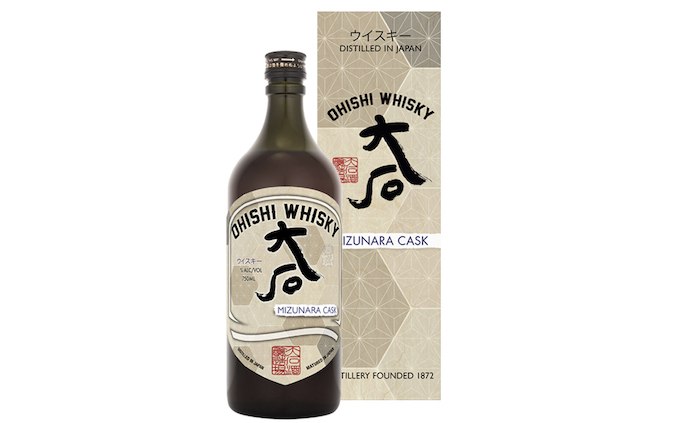Editor’s Note: This whiskey was provided to us as a review sample by Ohishi/ImpEx Beverages. This in no way, per our editorial policies, influenced the final outcome of this review. It should also be noted that by clicking the buy link towards the bottom of this review our site receives a small referral payment which helps to support, but not influence, our editorial and other costs.
If you consider the definition of whisky in America, Ohishi makes the cut. It’s fermented and distilled from grain, it ages in oak, and it’s distilled and bottled within appropriate ABV ranges. In Japan, however, it does not. Ohishi is closer to a Japanese spirit called shochu, a clear spirit that can be made from rice in addition to multiple other sources, and uses a fungus called koji for the fermentation. Ohishi’s aging adds too much color for Japan’s liking, making it neither shochu nor whisky.
The problem with this being: Japan doesn’t actually have a strict legal definition of whisky, doesn’t have a much better one for shochu, and the term “Japanese” doesn’t mean much at all. There is a long history of importing and blending or re-bottling whisky from Scotland and Canada that has recently cast doubt on Japanese labels.
Culture and history must be acknowledged here; firstly, that Japanese whisky started with blending, and was neither made from grain nor aged in wood until the 1960s. What these whisky producers are doing is a legal extension of their history, and considered a necessity created by current global demand. Also, the drinking culture of Japan is focused more on cocktails, particularly the highball, with the integrity of the spirit being a lesser concern. New restrictions and requirements are on the table, but current world events, as well as pushes from larger Japanese distilleries have put a hold on that.
Ohishi, luckily (depending on perspective), is a lesser part of all that. There is some objection to product made from rice being labelled as whisky for our markets, but Ohishi is not claiming to be made from anything it’s not (for the record, the United States defines rice as a grain). Ohishi even goes so far as to explain the origins of their rice. The distillery sits close to the Kuma River, making the land around it prime for rice growing (not to mention the water needed for whisky production). Ohishi uses gohyakumanishi rice from their own estate paddies, which accounts for 30% of the rice used in the whiskies, the rest being mochi rice from Kumamoto Prefecture.
This particular expression of Ohishi I’m reviewing here is being finished in Mizunara oak, a tree native to Japan and Northeast Asia. Not being accessible or easy to work with, Mizunara has become a specialty barrel most consistently and elegantly used by Suntory brand Yamazaki, though several global brands have released Mizunara finishes in the past few years.
Mizunara can only be harvested for barrels after about 200 years, making it one of the most exclusive (and expensive) woods available. Its use in Japanese whisky is rooted in necessity; Japan wasn’t able to import traditional ex-bourbon or sherry barrels for the aging of whisky during and immediately following the Second World War, precisely when they needed them most. The army was consuming a significant amount of the whisky, and the demand was not going down.
The Japanese needed to find a cask alternative within their own borders. The newfound use of Mizunara (which previously had been used mainly for furniture) wasn’t the cure-all that had been hoped for. Mizunara grows in twists and turns, providing a challenge to the coopers who make the barrels. From that point a lower porousness and higher moisture in the wood allows for higher chance of leakage and product loss – the last thing you want when the barrel was all that was available, or today when it costs an exorbitant amount of money. On top of all that, Mizunara is considered too harsh of a barrel if the whisky spends less than a decade (or two) in it.
Despite the challenges, or rather because of them, Mizunara has become a sought after and highly regarded cask choice for many whiskies within Japan and some outside of it. This unique and particular Ohishi whisky being finished in it adds to the intrigue of the expression. It also cements it as a product stooped in Japanese craft – perhaps even more so than the traditional “Japanese whisky.”

Tasting Notes: Ohishi 11 Year Old Mizunara Cask Finish
Vital Stats: 42.4% ABV, rice whiskey, aged 9 years in ex-brandy casks and finished 2 years in Mizunara, 750mL, $97
Appearance: Very weak chamomile tea
Nose: Spice paired with the yeasty aroma caused by koji (though it’s not a yeast) greet you at first, then sweeten into a light brown sugar from the spirit’s initial ex-brandy aging.
Palate: The initial taste is a fairly pleasant woodiness and spiciness, with a silky texture that’s less creamy than the original Ohishi releases. Next we get into a floral quality that may be like an incense called Kara, which is attributed to Mizunara but not a profile I’ve personally encountered. Unfortunately the woodiness doesn’t go away, and goes from being pleasant to rough and bitter in the short finish.







